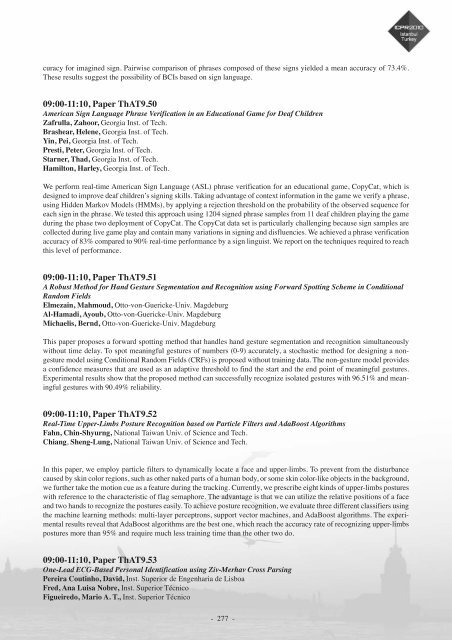Abstract book (pdf) - ICPR 2010
Abstract book (pdf) - ICPR 2010
Abstract book (pdf) - ICPR 2010
- TAGS
- abstract
- icpr
- icpr2010.org
You also want an ePaper? Increase the reach of your titles
YUMPU automatically turns print PDFs into web optimized ePapers that Google loves.
curacy for imagined sign. Pairwise comparison of phrases composed of these signs yielded a mean accuracy of 73.4%.<br />
These results suggest the possibility of BCIs based on sign language.<br />
09:00-11:10, Paper ThAT9.50<br />
American Sign Language Phrase Verification in an Educational Game for Deaf Children<br />
Zafrulla, Zahoor, Georgia Inst. of Tech.<br />
Brashear, Helene, Georgia Inst. of Tech.<br />
Yin, Pei, Georgia Inst. of Tech.<br />
Presti, Peter, Georgia Inst. of Tech.<br />
Starner, Thad, Georgia Inst. of Tech.<br />
Hamilton, Harley, Georgia Inst. of Tech.<br />
We perform real-time American Sign Language (ASL) phrase verification for an educational game, CopyCat, which is<br />
designed to improve deaf children’s signing skills. Taking advantage of context information in the game we verify a phrase,<br />
using Hidden Markov Models (HMMs), by applying a rejection threshold on the probability of the observed sequence for<br />
each sign in the phrase. We tested this approach using 1204 signed phrase samples from 11 deaf children playing the game<br />
during the phase two deployment of CopyCat. The CopyCat data set is particularly challenging because sign samples are<br />
collected during live game play and contain many variations in signing and disfluencies. We achieved a phrase verification<br />
accuracy of 83% compared to 90% real-time performance by a sign linguist. We report on the techniques required to reach<br />
this level of performance.<br />
09:00-11:10, Paper ThAT9.51<br />
A Robust Method for Hand Gesture Segmentation and Recognition using Forward Spotting Scheme in Conditional<br />
Random Fields<br />
Elmezain, Mahmoud, Otto-von-Guericke-Univ. Magdeburg<br />
Al-Hamadi, Ayoub, Otto-von-Guericke-Univ. Magdeburg<br />
Michaelis, Bernd, Otto-von-Guericke-Univ. Magdeburg<br />
This paper proposes a forward spotting method that handles hand gesture segmentation and recognition simultaneously<br />
without time delay. To spot meaningful gestures of numbers (0-9) accurately, a stochastic method for designing a nongesture<br />
model using Conditional Random Fields (CRFs) is proposed without training data. The non-gesture model provides<br />
a confidence measures that are used as an adaptive threshold to find the start and the end point of meaningful gestures.<br />
Experimental results show that the proposed method can successfully recognize isolated gestures with 96.51% and meaningful<br />
gestures with 90.49% reliability.<br />
09:00-11:10, Paper ThAT9.52<br />
Real-Time Upper-Limbs Posture Recognition based on Particle Filters and AdaBoost Algorithms<br />
Fahn, Chin-Shyurng, National Taiwan Univ. of Science and Tech.<br />
Chiang, Sheng-Lung, National Taiwan Univ. of Science and Tech.<br />
In this paper, we employ particle filters to dynamically locate a face and upper-limbs. To prevent from the disturbance<br />
caused by skin color regions, such as other naked parts of a human body, or some skin color-like objects in the background,<br />
we further take the motion cue as a feature during the tracking. Currently, we prescribe eight kinds of upper-limbs postures<br />
with reference to the characteristic of flag semaphore. The advantage is that we can utilize the relative positions of a face<br />
and two hands to recognize the postures easily. To achieve posture recognition, we evaluate three different classifiers using<br />
the machine learning methods: multi-layer perceptrons, support vector machines, and AdaBoost algorithms. The experimental<br />
results reveal that AdaBoost algorithms are the best one, which reach the accuracy rate of recognizing upper-limbs<br />
postures more than 95% and require much less training time than the other two do.<br />
09:00-11:10, Paper ThAT9.53<br />
One-Lead ECG-Based Personal Identification using Ziv-Merhav Cross Parsing<br />
Pereira Coutinho, David, Inst. Superior de Engenharia de Lisboa<br />
Fred, Ana Luisa Nobre, Inst. Superior Técnico<br />
Figueiredo, Mario A. T., Inst. Superior Técnico<br />
- 277 -



